Principles of Administration Report: Aldi, Office Management
VerifiedAdded on 2020/06/04
|11
|3076
|207
Report
AI Summary
This report delves into the principles of administration, using Aldi as a case study to illustrate key concepts. It comprehensively covers various aspects of office management, including legal requirements, service provision, and the establishment of effective procedures. The report further examines health and safety in the workplace, outlining employer obligations and individual responsibilities, along with accident and emergency protocols. A significant portion is dedicated to the intricacies of meeting minutes, encompassing their purpose, legal implications, accuracy, and the appropriate content for different meeting types. The report also explores formal and informal meetings, the roles within them, and facilitation techniques. Furthermore, it addresses workload management through targets, budgets, and effective allocation of tasks. Quality management techniques and methods for identifying improvements in team outputs are also discussed. Finally, the report examines event planning, including event characteristics, information requirements, and planning processes. References are provided at the end for further reading.
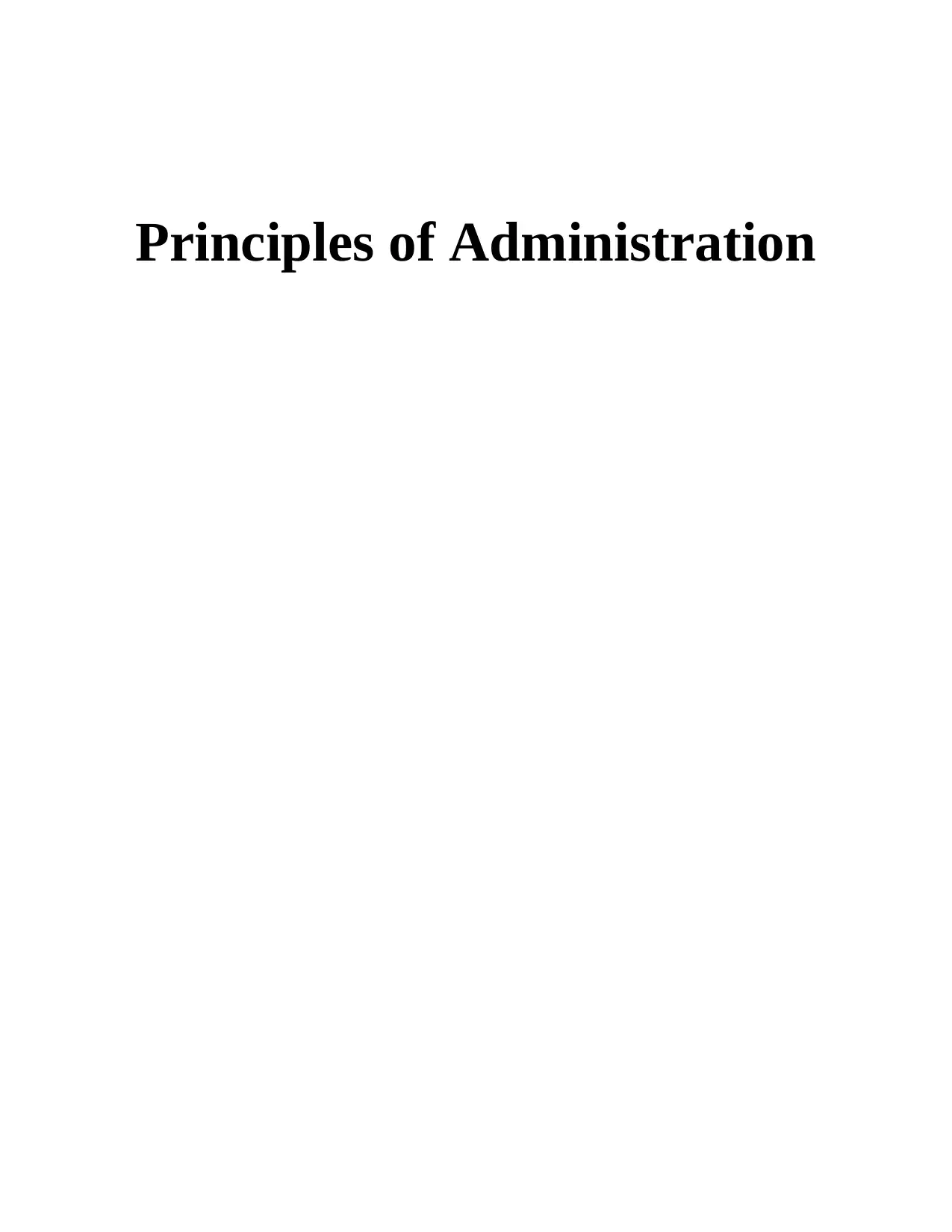
Principles of Administration
Paraphrase This Document
Need a fresh take? Get an instant paraphrase of this document with our AI Paraphraser
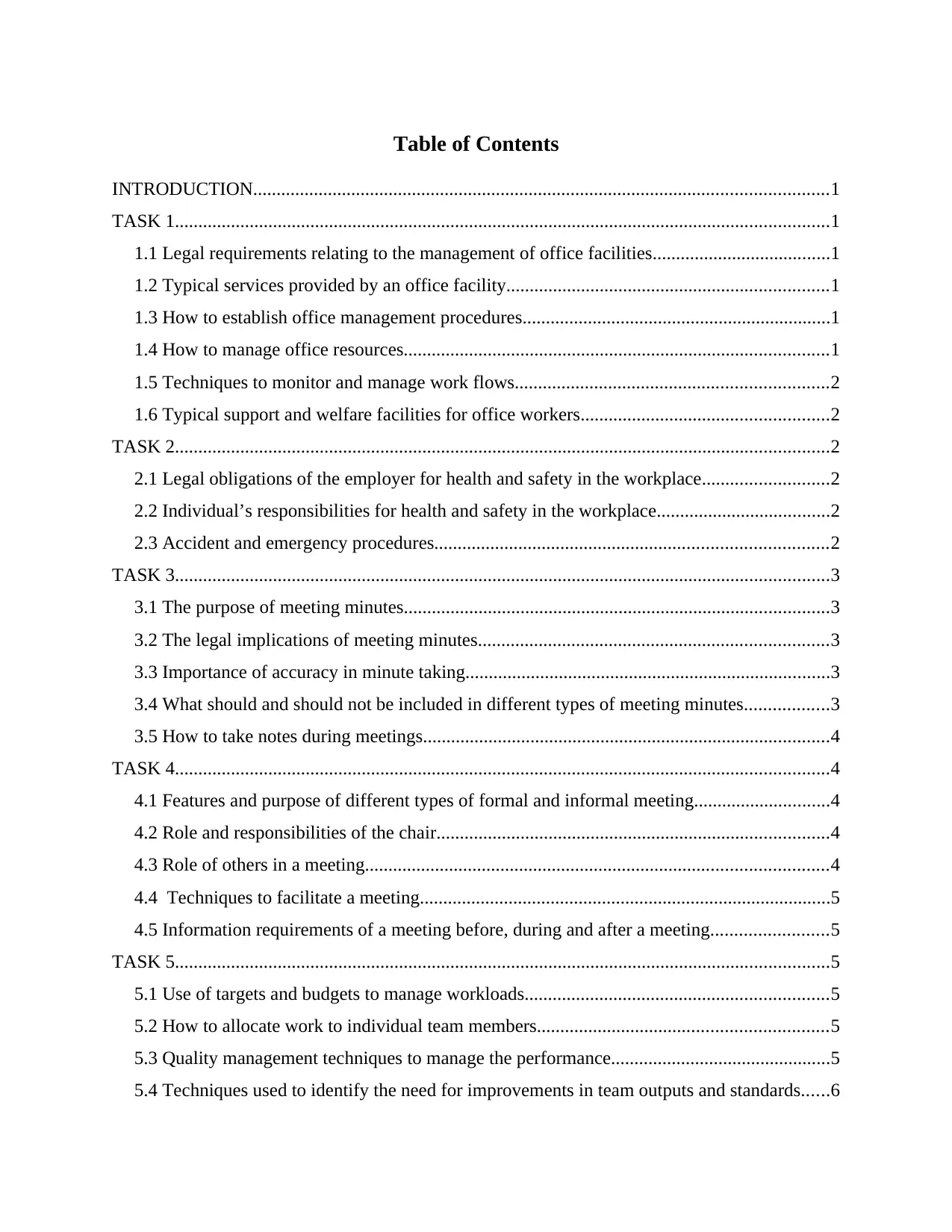
Table of Contents
INTRODUCTION...........................................................................................................................1
TASK 1............................................................................................................................................1
1.1 Legal requirements relating to the management of office facilities......................................1
1.2 Typical services provided by an office facility.....................................................................1
1.3 How to establish office management procedures..................................................................1
1.4 How to manage office resources...........................................................................................1
1.5 Techniques to monitor and manage work flows...................................................................2
1.6 Typical support and welfare facilities for office workers.....................................................2
TASK 2............................................................................................................................................2
2.1 Legal obligations of the employer for health and safety in the workplace...........................2
2.2 Individual’s responsibilities for health and safety in the workplace.....................................2
2.3 Accident and emergency procedures....................................................................................2
TASK 3............................................................................................................................................3
3.1 The purpose of meeting minutes...........................................................................................3
3.2 The legal implications of meeting minutes...........................................................................3
3.3 Importance of accuracy in minute taking..............................................................................3
3.4 What should and should not be included in different types of meeting minutes..................3
3.5 How to take notes during meetings.......................................................................................4
TASK 4............................................................................................................................................4
4.1 Features and purpose of different types of formal and informal meeting.............................4
4.2 Role and responsibilities of the chair....................................................................................4
4.3 Role of others in a meeting...................................................................................................4
4.4 Techniques to facilitate a meeting........................................................................................5
4.5 Information requirements of a meeting before, during and after a meeting.........................5
TASK 5............................................................................................................................................5
5.1 Use of targets and budgets to manage workloads.................................................................5
5.2 How to allocate work to individual team members..............................................................5
5.3 Quality management techniques to manage the performance...............................................5
5.4 Techniques used to identify the need for improvements in team outputs and standards......6
INTRODUCTION...........................................................................................................................1
TASK 1............................................................................................................................................1
1.1 Legal requirements relating to the management of office facilities......................................1
1.2 Typical services provided by an office facility.....................................................................1
1.3 How to establish office management procedures..................................................................1
1.4 How to manage office resources...........................................................................................1
1.5 Techniques to monitor and manage work flows...................................................................2
1.6 Typical support and welfare facilities for office workers.....................................................2
TASK 2............................................................................................................................................2
2.1 Legal obligations of the employer for health and safety in the workplace...........................2
2.2 Individual’s responsibilities for health and safety in the workplace.....................................2
2.3 Accident and emergency procedures....................................................................................2
TASK 3............................................................................................................................................3
3.1 The purpose of meeting minutes...........................................................................................3
3.2 The legal implications of meeting minutes...........................................................................3
3.3 Importance of accuracy in minute taking..............................................................................3
3.4 What should and should not be included in different types of meeting minutes..................3
3.5 How to take notes during meetings.......................................................................................4
TASK 4............................................................................................................................................4
4.1 Features and purpose of different types of formal and informal meeting.............................4
4.2 Role and responsibilities of the chair....................................................................................4
4.3 Role of others in a meeting...................................................................................................4
4.4 Techniques to facilitate a meeting........................................................................................5
4.5 Information requirements of a meeting before, during and after a meeting.........................5
TASK 5............................................................................................................................................5
5.1 Use of targets and budgets to manage workloads.................................................................5
5.2 How to allocate work to individual team members..............................................................5
5.3 Quality management techniques to manage the performance...............................................5
5.4 Techniques used to identify the need for improvements in team outputs and standards......6
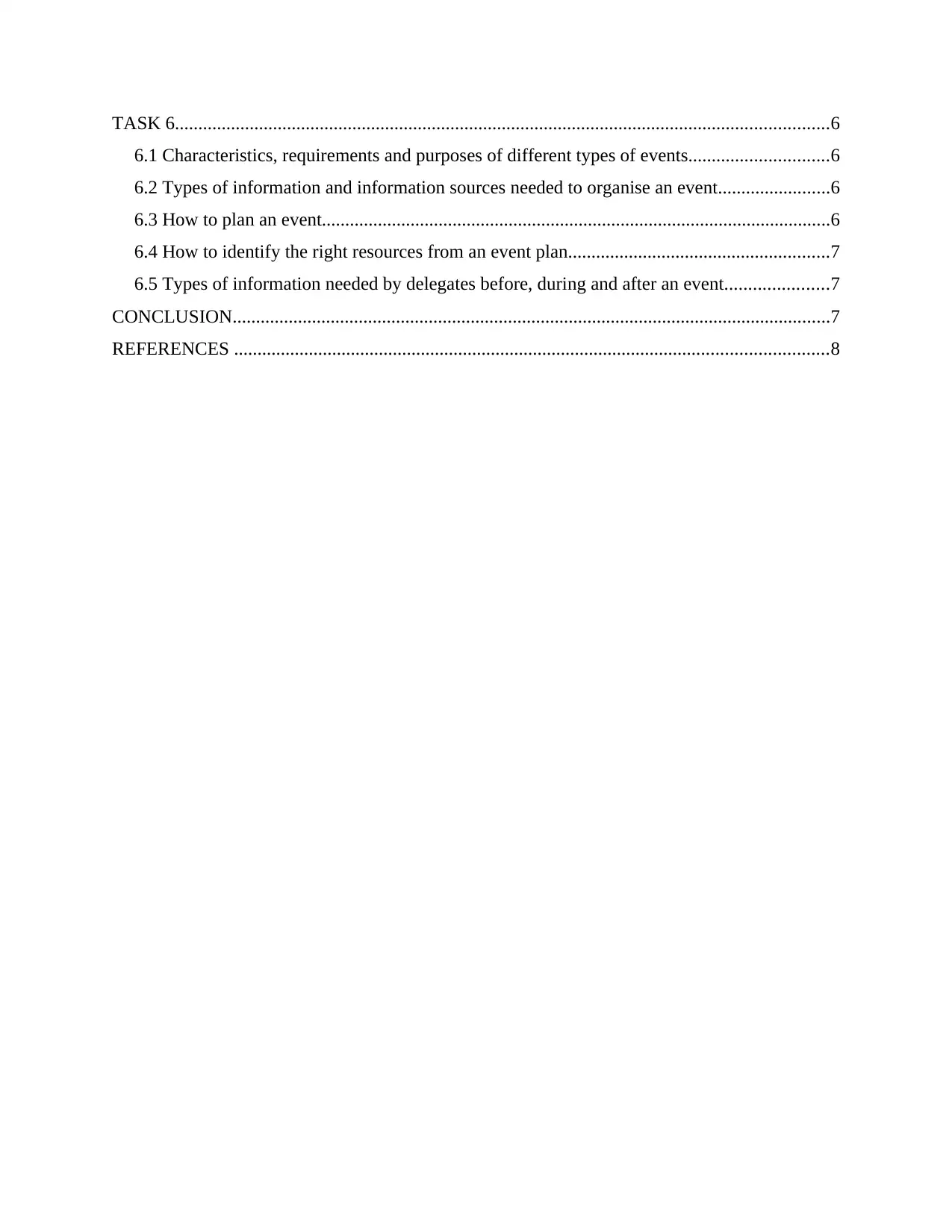
TASK 6............................................................................................................................................6
6.1 Characteristics, requirements and purposes of different types of events..............................6
6.2 Types of information and information sources needed to organise an event........................6
6.3 How to plan an event.............................................................................................................6
6.4 How to identify the right resources from an event plan........................................................7
6.5 Types of information needed by delegates before, during and after an event......................7
CONCLUSION................................................................................................................................7
REFERENCES ...............................................................................................................................8
6.1 Characteristics, requirements and purposes of different types of events..............................6
6.2 Types of information and information sources needed to organise an event........................6
6.3 How to plan an event.............................................................................................................6
6.4 How to identify the right resources from an event plan........................................................7
6.5 Types of information needed by delegates before, during and after an event......................7
CONCLUSION................................................................................................................................7
REFERENCES ...............................................................................................................................8
⊘ This is a preview!⊘
Do you want full access?
Subscribe today to unlock all pages.

Trusted by 1+ million students worldwide
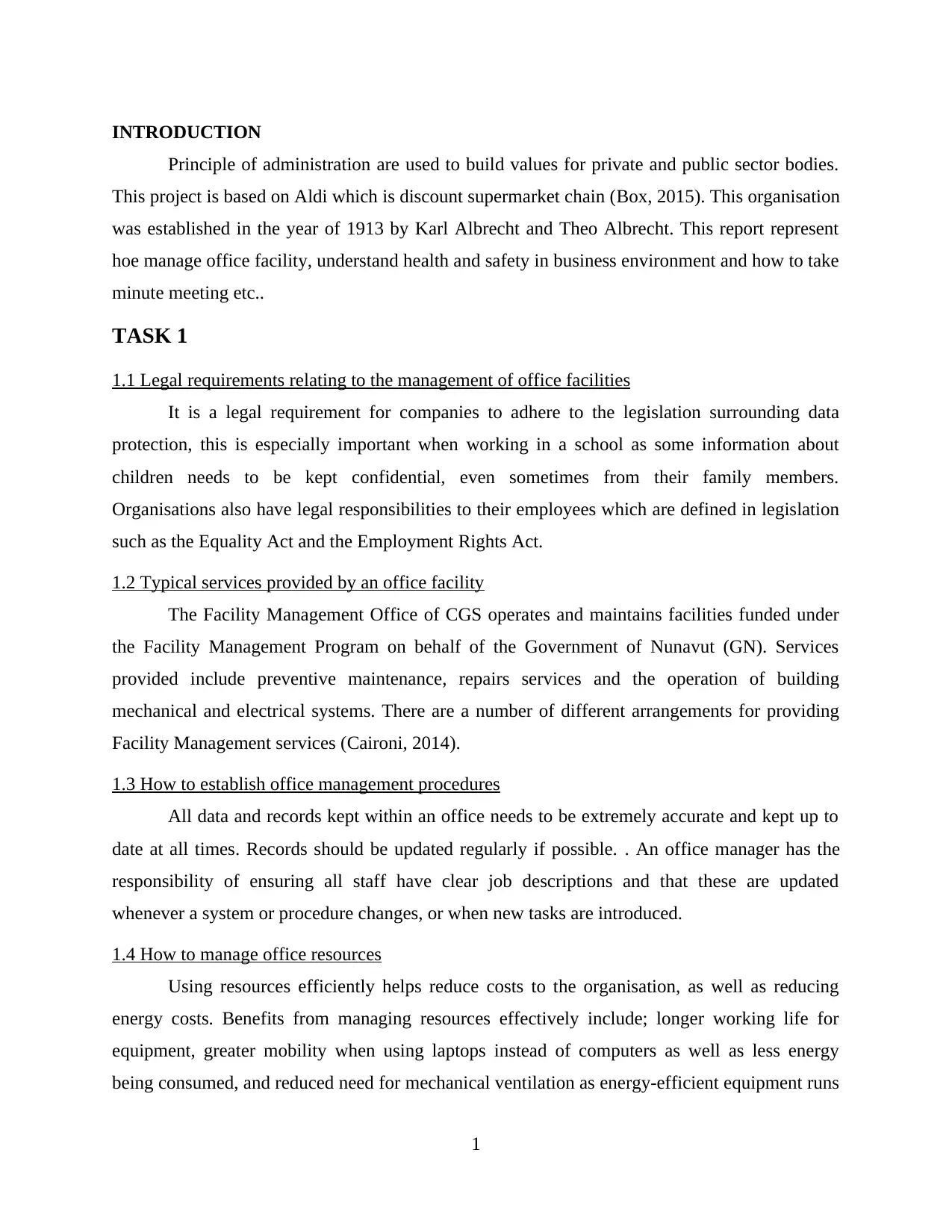
INTRODUCTION
Principle of administration are used to build values for private and public sector bodies.
This project is based on Aldi which is discount supermarket chain (Box, 2015). This organisation
was established in the year of 1913 by Karl Albrecht and Theo Albrecht. This report represent
hoe manage office facility, understand health and safety in business environment and how to take
minute meeting etc..
TASK 1
1.1 Legal requirements relating to the management of office facilities
It is a legal requirement for companies to adhere to the legislation surrounding data
protection, this is especially important when working in a school as some information about
children needs to be kept confidential, even sometimes from their family members.
Organisations also have legal responsibilities to their employees which are defined in legislation
such as the Equality Act and the Employment Rights Act.
1.2 Typical services provided by an office facility
The Facility Management Office of CGS operates and maintains facilities funded under
the Facility Management Program on behalf of the Government of Nunavut (GN). Services
provided include preventive maintenance, repairs services and the operation of building
mechanical and electrical systems. There are a number of different arrangements for providing
Facility Management services (Caironi, 2014).
1.3 How to establish office management procedures
All data and records kept within an office needs to be extremely accurate and kept up to
date at all times. Records should be updated regularly if possible. . An office manager has the
responsibility of ensuring all staff have clear job descriptions and that these are updated
whenever a system or procedure changes, or when new tasks are introduced.
1.4 How to manage office resources
Using resources efficiently helps reduce costs to the organisation, as well as reducing
energy costs. Benefits from managing resources effectively include; longer working life for
equipment, greater mobility when using laptops instead of computers as well as less energy
being consumed, and reduced need for mechanical ventilation as energy-efficient equipment runs
1
Principle of administration are used to build values for private and public sector bodies.
This project is based on Aldi which is discount supermarket chain (Box, 2015). This organisation
was established in the year of 1913 by Karl Albrecht and Theo Albrecht. This report represent
hoe manage office facility, understand health and safety in business environment and how to take
minute meeting etc..
TASK 1
1.1 Legal requirements relating to the management of office facilities
It is a legal requirement for companies to adhere to the legislation surrounding data
protection, this is especially important when working in a school as some information about
children needs to be kept confidential, even sometimes from their family members.
Organisations also have legal responsibilities to their employees which are defined in legislation
such as the Equality Act and the Employment Rights Act.
1.2 Typical services provided by an office facility
The Facility Management Office of CGS operates and maintains facilities funded under
the Facility Management Program on behalf of the Government of Nunavut (GN). Services
provided include preventive maintenance, repairs services and the operation of building
mechanical and electrical systems. There are a number of different arrangements for providing
Facility Management services (Caironi, 2014).
1.3 How to establish office management procedures
All data and records kept within an office needs to be extremely accurate and kept up to
date at all times. Records should be updated regularly if possible. . An office manager has the
responsibility of ensuring all staff have clear job descriptions and that these are updated
whenever a system or procedure changes, or when new tasks are introduced.
1.4 How to manage office resources
Using resources efficiently helps reduce costs to the organisation, as well as reducing
energy costs. Benefits from managing resources effectively include; longer working life for
equipment, greater mobility when using laptops instead of computers as well as less energy
being consumed, and reduced need for mechanical ventilation as energy-efficient equipment runs
1
Paraphrase This Document
Need a fresh take? Get an instant paraphrase of this document with our AI Paraphraser
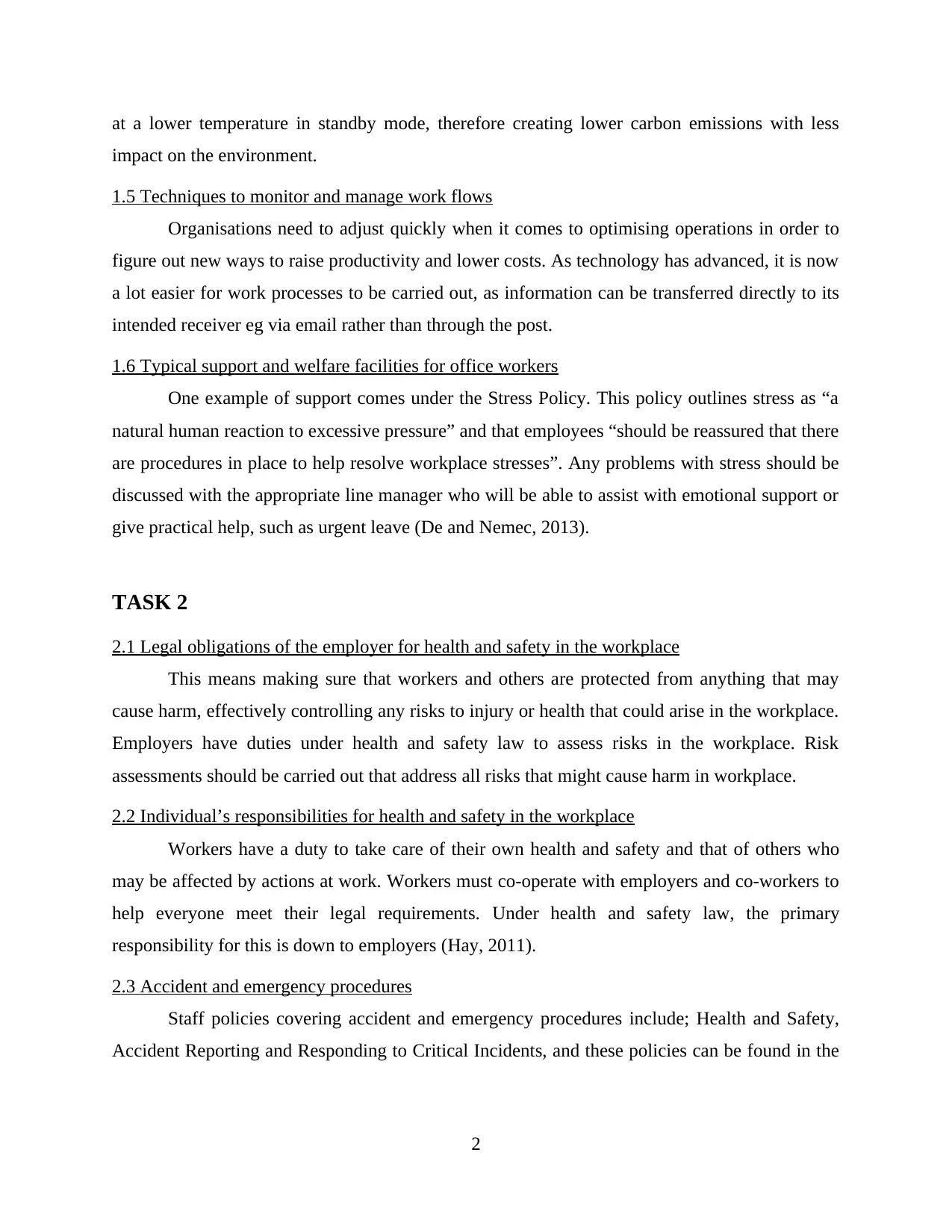
at a lower temperature in standby mode, therefore creating lower carbon emissions with less
impact on the environment.
1.5 Techniques to monitor and manage work flows
Organisations need to adjust quickly when it comes to optimising operations in order to
figure out new ways to raise productivity and lower costs. As technology has advanced, it is now
a lot easier for work processes to be carried out, as information can be transferred directly to its
intended receiver eg via email rather than through the post.
1.6 Typical support and welfare facilities for office workers
One example of support comes under the Stress Policy. This policy outlines stress as “a
natural human reaction to excessive pressure” and that employees “should be reassured that there
are procedures in place to help resolve workplace stresses”. Any problems with stress should be
discussed with the appropriate line manager who will be able to assist with emotional support or
give practical help, such as urgent leave (De and Nemec, 2013).
TASK 2
2.1 Legal obligations of the employer for health and safety in the workplace
This means making sure that workers and others are protected from anything that may
cause harm, effectively controlling any risks to injury or health that could arise in the workplace.
Employers have duties under health and safety law to assess risks in the workplace. Risk
assessments should be carried out that address all risks that might cause harm in workplace.
2.2 Individual’s responsibilities for health and safety in the workplace
Workers have a duty to take care of their own health and safety and that of others who
may be affected by actions at work. Workers must co-operate with employers and co-workers to
help everyone meet their legal requirements. Under health and safety law, the primary
responsibility for this is down to employers (Hay, 2011).
2.3 Accident and emergency procedures
Staff policies covering accident and emergency procedures include; Health and Safety,
Accident Reporting and Responding to Critical Incidents, and these policies can be found in the
2
impact on the environment.
1.5 Techniques to monitor and manage work flows
Organisations need to adjust quickly when it comes to optimising operations in order to
figure out new ways to raise productivity and lower costs. As technology has advanced, it is now
a lot easier for work processes to be carried out, as information can be transferred directly to its
intended receiver eg via email rather than through the post.
1.6 Typical support and welfare facilities for office workers
One example of support comes under the Stress Policy. This policy outlines stress as “a
natural human reaction to excessive pressure” and that employees “should be reassured that there
are procedures in place to help resolve workplace stresses”. Any problems with stress should be
discussed with the appropriate line manager who will be able to assist with emotional support or
give practical help, such as urgent leave (De and Nemec, 2013).
TASK 2
2.1 Legal obligations of the employer for health and safety in the workplace
This means making sure that workers and others are protected from anything that may
cause harm, effectively controlling any risks to injury or health that could arise in the workplace.
Employers have duties under health and safety law to assess risks in the workplace. Risk
assessments should be carried out that address all risks that might cause harm in workplace.
2.2 Individual’s responsibilities for health and safety in the workplace
Workers have a duty to take care of their own health and safety and that of others who
may be affected by actions at work. Workers must co-operate with employers and co-workers to
help everyone meet their legal requirements. Under health and safety law, the primary
responsibility for this is down to employers (Hay, 2011).
2.3 Accident and emergency procedures
Staff policies covering accident and emergency procedures include; Health and Safety,
Accident Reporting and Responding to Critical Incidents, and these policies can be found in the
2
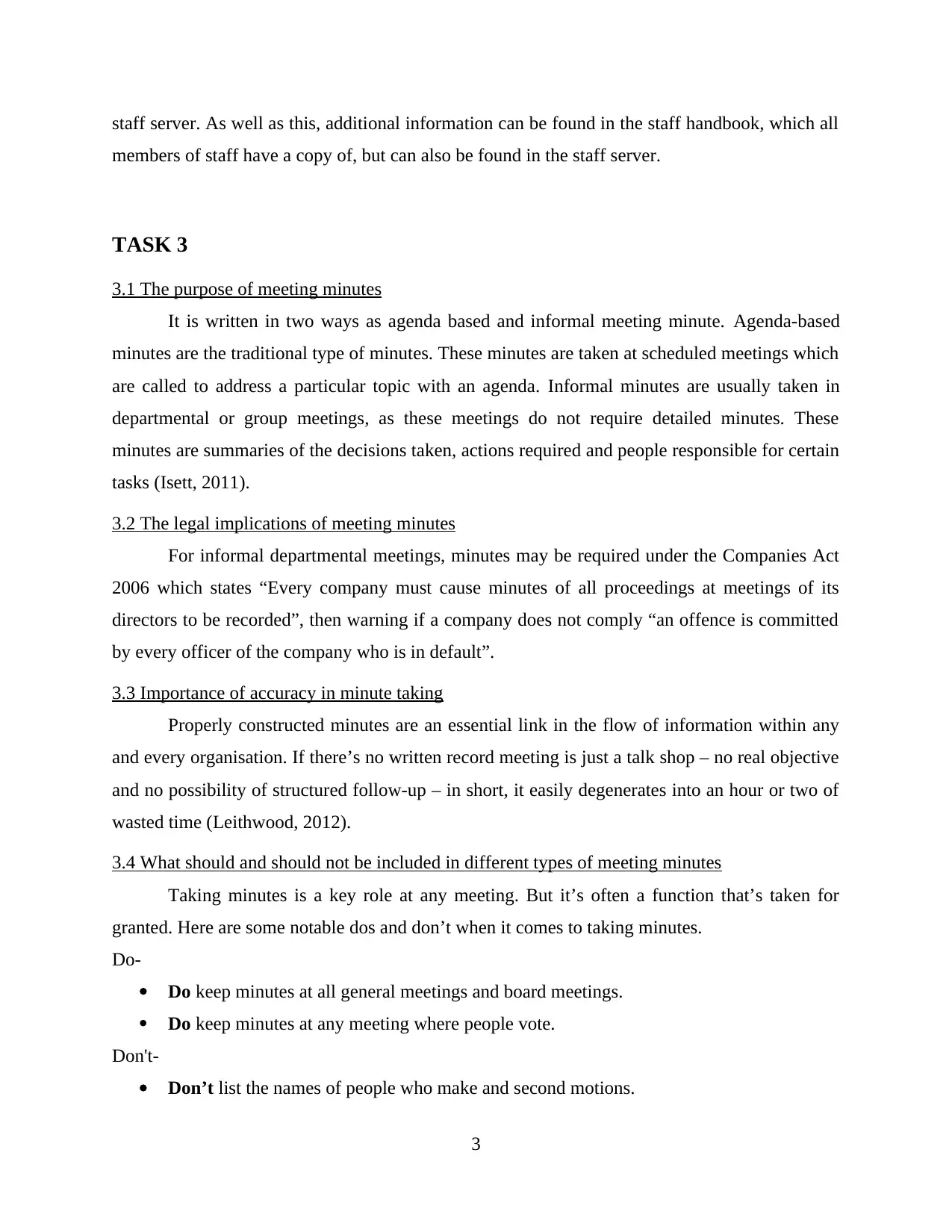
staff server. As well as this, additional information can be found in the staff handbook, which all
members of staff have a copy of, but can also be found in the staff server.
TASK 3
3.1 The purpose of meeting minutes
It is written in two ways as agenda based and informal meeting minute. Agenda-based
minutes are the traditional type of minutes. These minutes are taken at scheduled meetings which
are called to address a particular topic with an agenda. Informal minutes are usually taken in
departmental or group meetings, as these meetings do not require detailed minutes. These
minutes are summaries of the decisions taken, actions required and people responsible for certain
tasks (Isett, 2011).
3.2 The legal implications of meeting minutes
For informal departmental meetings, minutes may be required under the Companies Act
2006 which states “Every company must cause minutes of all proceedings at meetings of its
directors to be recorded”, then warning if a company does not comply “an offence is committed
by every officer of the company who is in default”.
3.3 Importance of accuracy in minute taking
Properly constructed minutes are an essential link in the flow of information within any
and every organisation. If there’s no written record meeting is just a talk shop – no real objective
and no possibility of structured follow-up – in short, it easily degenerates into an hour or two of
wasted time (Leithwood, 2012).
3.4 What should and should not be included in different types of meeting minutes
Taking minutes is a key role at any meeting. But it’s often a function that’s taken for
granted. Here are some notable dos and don’t when it comes to taking minutes.
Do-
Do keep minutes at all general meetings and board meetings.
Do keep minutes at any meeting where people vote.
Don't-
Don’t list the names of people who make and second motions.
3
members of staff have a copy of, but can also be found in the staff server.
TASK 3
3.1 The purpose of meeting minutes
It is written in two ways as agenda based and informal meeting minute. Agenda-based
minutes are the traditional type of minutes. These minutes are taken at scheduled meetings which
are called to address a particular topic with an agenda. Informal minutes are usually taken in
departmental or group meetings, as these meetings do not require detailed minutes. These
minutes are summaries of the decisions taken, actions required and people responsible for certain
tasks (Isett, 2011).
3.2 The legal implications of meeting minutes
For informal departmental meetings, minutes may be required under the Companies Act
2006 which states “Every company must cause minutes of all proceedings at meetings of its
directors to be recorded”, then warning if a company does not comply “an offence is committed
by every officer of the company who is in default”.
3.3 Importance of accuracy in minute taking
Properly constructed minutes are an essential link in the flow of information within any
and every organisation. If there’s no written record meeting is just a talk shop – no real objective
and no possibility of structured follow-up – in short, it easily degenerates into an hour or two of
wasted time (Leithwood, 2012).
3.4 What should and should not be included in different types of meeting minutes
Taking minutes is a key role at any meeting. But it’s often a function that’s taken for
granted. Here are some notable dos and don’t when it comes to taking minutes.
Do-
Do keep minutes at all general meetings and board meetings.
Do keep minutes at any meeting where people vote.
Don't-
Don’t list the names of people who make and second motions.
3
⊘ This is a preview!⊘
Do you want full access?
Subscribe today to unlock all pages.

Trusted by 1+ million students worldwide
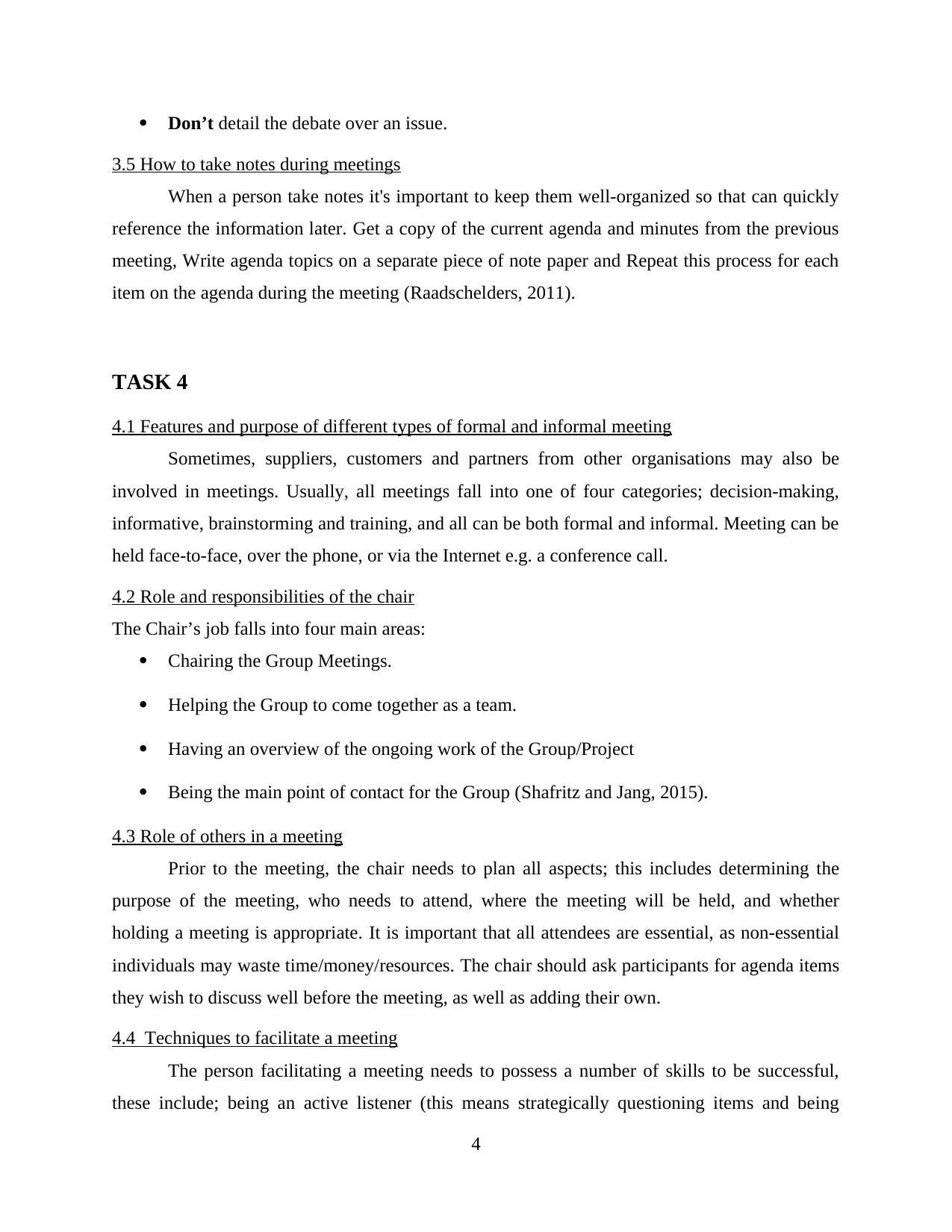
Don’t detail the debate over an issue.
3.5 How to take notes during meetings
When a person take notes it's important to keep them well-organized so that can quickly
reference the information later. Get a copy of the current agenda and minutes from the previous
meeting, Write agenda topics on a separate piece of note paper and Repeat this process for each
item on the agenda during the meeting (Raadschelders, 2011).
TASK 4
4.1 Features and purpose of different types of formal and informal meeting
Sometimes, suppliers, customers and partners from other organisations may also be
involved in meetings. Usually, all meetings fall into one of four categories; decision-making,
informative, brainstorming and training, and all can be both formal and informal. Meeting can be
held face-to-face, over the phone, or via the Internet e.g. a conference call.
4.2 Role and responsibilities of the chair
The Chair’s job falls into four main areas:
Chairing the Group Meetings.
Helping the Group to come together as a team.
Having an overview of the ongoing work of the Group/Project
Being the main point of contact for the Group (Shafritz and Jang, 2015).
4.3 Role of others in a meeting
Prior to the meeting, the chair needs to plan all aspects; this includes determining the
purpose of the meeting, who needs to attend, where the meeting will be held, and whether
holding a meeting is appropriate. It is important that all attendees are essential, as non-essential
individuals may waste time/money/resources. The chair should ask participants for agenda items
they wish to discuss well before the meeting, as well as adding their own.
4.4 Techniques to facilitate a meeting
The person facilitating a meeting needs to possess a number of skills to be successful,
these include; being an active listener (this means strategically questioning items and being
4
3.5 How to take notes during meetings
When a person take notes it's important to keep them well-organized so that can quickly
reference the information later. Get a copy of the current agenda and minutes from the previous
meeting, Write agenda topics on a separate piece of note paper and Repeat this process for each
item on the agenda during the meeting (Raadschelders, 2011).
TASK 4
4.1 Features and purpose of different types of formal and informal meeting
Sometimes, suppliers, customers and partners from other organisations may also be
involved in meetings. Usually, all meetings fall into one of four categories; decision-making,
informative, brainstorming and training, and all can be both formal and informal. Meeting can be
held face-to-face, over the phone, or via the Internet e.g. a conference call.
4.2 Role and responsibilities of the chair
The Chair’s job falls into four main areas:
Chairing the Group Meetings.
Helping the Group to come together as a team.
Having an overview of the ongoing work of the Group/Project
Being the main point of contact for the Group (Shafritz and Jang, 2015).
4.3 Role of others in a meeting
Prior to the meeting, the chair needs to plan all aspects; this includes determining the
purpose of the meeting, who needs to attend, where the meeting will be held, and whether
holding a meeting is appropriate. It is important that all attendees are essential, as non-essential
individuals may waste time/money/resources. The chair should ask participants for agenda items
they wish to discuss well before the meeting, as well as adding their own.
4.4 Techniques to facilitate a meeting
The person facilitating a meeting needs to possess a number of skills to be successful,
these include; being an active listener (this means strategically questioning items and being
4
Paraphrase This Document
Need a fresh take? Get an instant paraphrase of this document with our AI Paraphraser
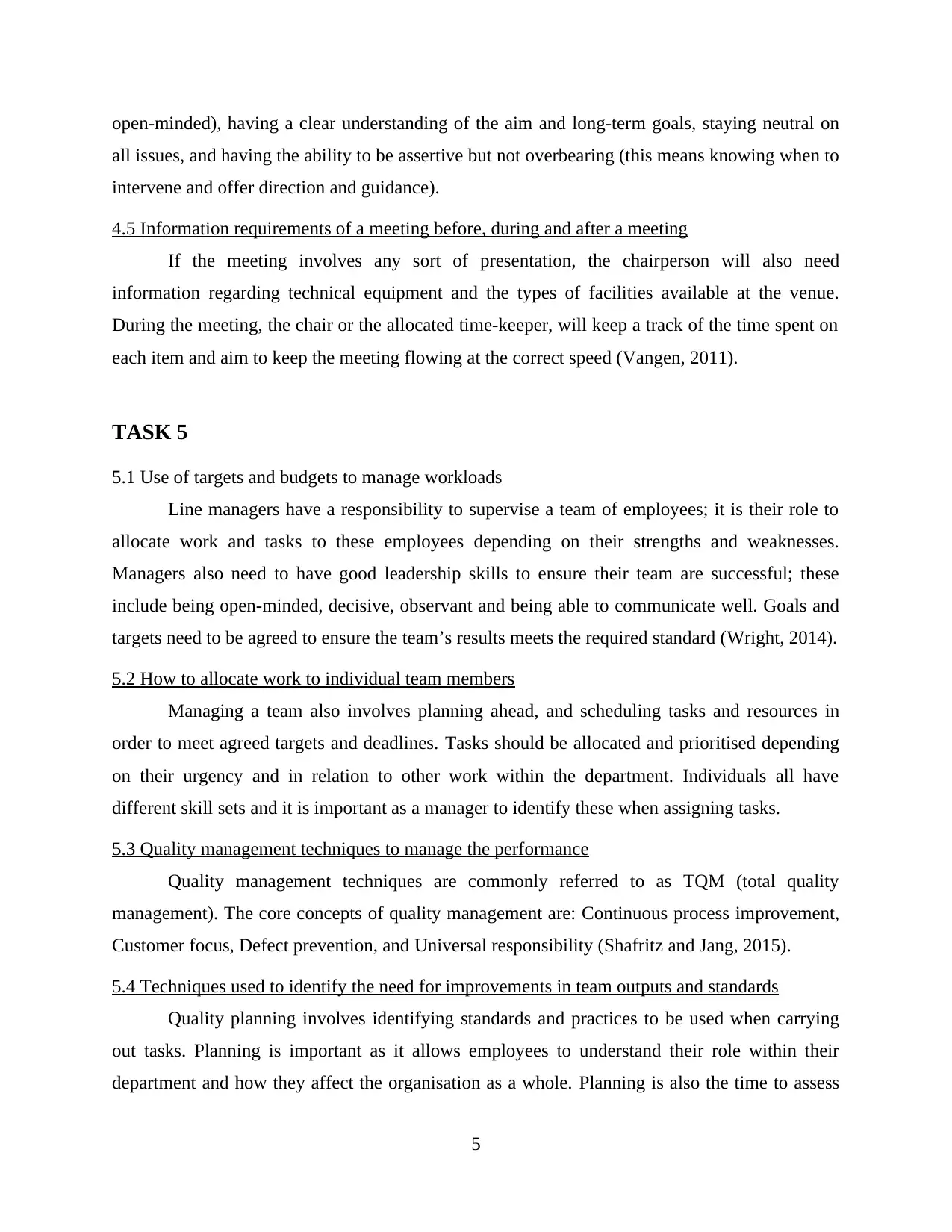
open-minded), having a clear understanding of the aim and long-term goals, staying neutral on
all issues, and having the ability to be assertive but not overbearing (this means knowing when to
intervene and offer direction and guidance).
4.5 Information requirements of a meeting before, during and after a meeting
If the meeting involves any sort of presentation, the chairperson will also need
information regarding technical equipment and the types of facilities available at the venue.
During the meeting, the chair or the allocated time-keeper, will keep a track of the time spent on
each item and aim to keep the meeting flowing at the correct speed (Vangen, 2011).
TASK 5
5.1 Use of targets and budgets to manage workloads
Line managers have a responsibility to supervise a team of employees; it is their role to
allocate work and tasks to these employees depending on their strengths and weaknesses.
Managers also need to have good leadership skills to ensure their team are successful; these
include being open-minded, decisive, observant and being able to communicate well. Goals and
targets need to be agreed to ensure the team’s results meets the required standard (Wright, 2014).
5.2 How to allocate work to individual team members
Managing a team also involves planning ahead, and scheduling tasks and resources in
order to meet agreed targets and deadlines. Tasks should be allocated and prioritised depending
on their urgency and in relation to other work within the department. Individuals all have
different skill sets and it is important as a manager to identify these when assigning tasks.
5.3 Quality management techniques to manage the performance
Quality management techniques are commonly referred to as TQM (total quality
management). The core concepts of quality management are: Continuous process improvement,
Customer focus, Defect prevention, and Universal responsibility (Shafritz and Jang, 2015).
5.4 Techniques used to identify the need for improvements in team outputs and standards
Quality planning involves identifying standards and practices to be used when carrying
out tasks. Planning is important as it allows employees to understand their role within their
department and how they affect the organisation as a whole. Planning is also the time to assess
5
all issues, and having the ability to be assertive but not overbearing (this means knowing when to
intervene and offer direction and guidance).
4.5 Information requirements of a meeting before, during and after a meeting
If the meeting involves any sort of presentation, the chairperson will also need
information regarding technical equipment and the types of facilities available at the venue.
During the meeting, the chair or the allocated time-keeper, will keep a track of the time spent on
each item and aim to keep the meeting flowing at the correct speed (Vangen, 2011).
TASK 5
5.1 Use of targets and budgets to manage workloads
Line managers have a responsibility to supervise a team of employees; it is their role to
allocate work and tasks to these employees depending on their strengths and weaknesses.
Managers also need to have good leadership skills to ensure their team are successful; these
include being open-minded, decisive, observant and being able to communicate well. Goals and
targets need to be agreed to ensure the team’s results meets the required standard (Wright, 2014).
5.2 How to allocate work to individual team members
Managing a team also involves planning ahead, and scheduling tasks and resources in
order to meet agreed targets and deadlines. Tasks should be allocated and prioritised depending
on their urgency and in relation to other work within the department. Individuals all have
different skill sets and it is important as a manager to identify these when assigning tasks.
5.3 Quality management techniques to manage the performance
Quality management techniques are commonly referred to as TQM (total quality
management). The core concepts of quality management are: Continuous process improvement,
Customer focus, Defect prevention, and Universal responsibility (Shafritz and Jang, 2015).
5.4 Techniques used to identify the need for improvements in team outputs and standards
Quality planning involves identifying standards and practices to be used when carrying
out tasks. Planning is important as it allows employees to understand their role within their
department and how they affect the organisation as a whole. Planning is also the time to assess
5
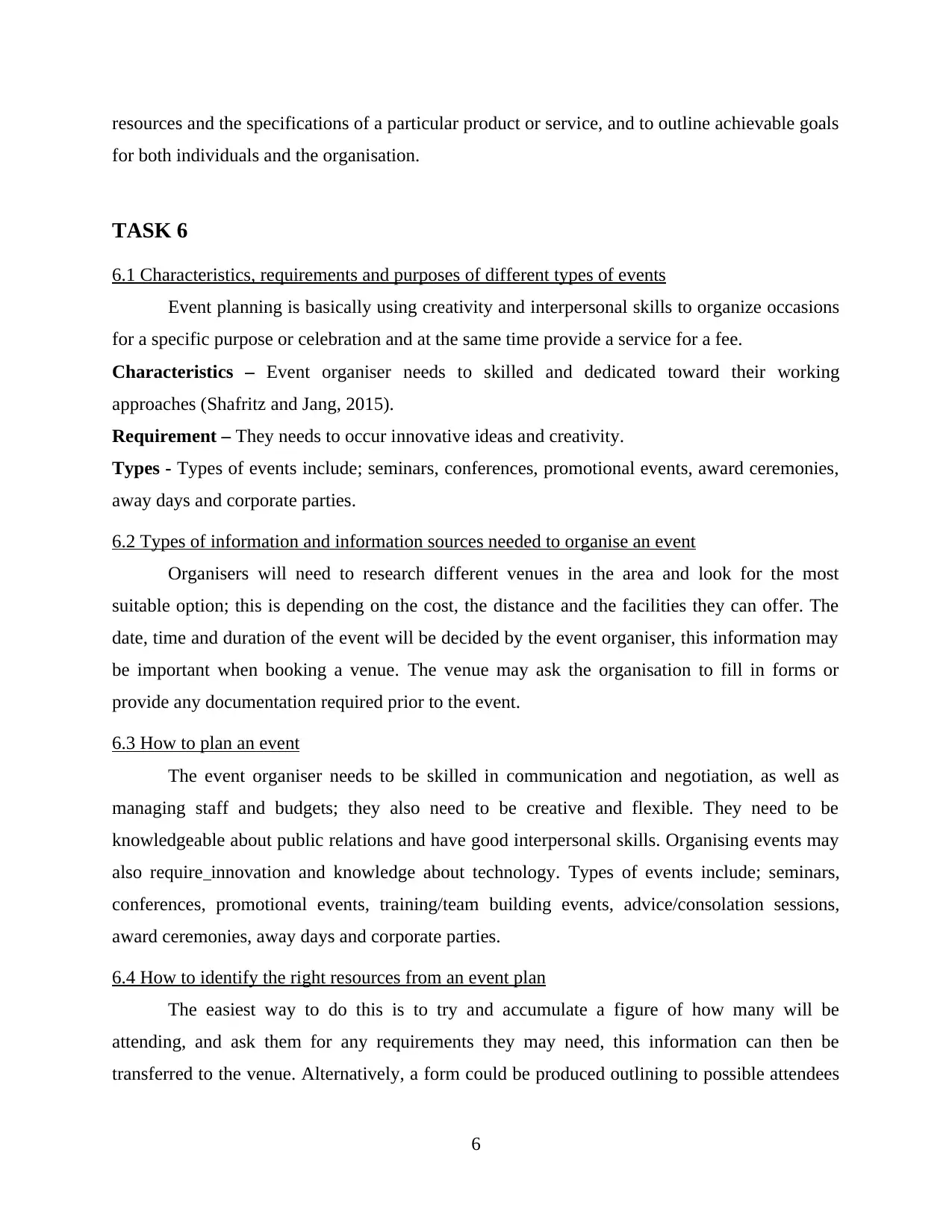
resources and the specifications of a particular product or service, and to outline achievable goals
for both individuals and the organisation.
TASK 6
6.1 Characteristics, requirements and purposes of different types of events
Event planning is basically using creativity and interpersonal skills to organize occasions
for a specific purpose or celebration and at the same time provide a service for a fee.
Characteristics – Event organiser needs to skilled and dedicated toward their working
approaches (Shafritz and Jang, 2015).
Requirement – They needs to occur innovative ideas and creativity.
Types - Types of events include; seminars, conferences, promotional events, award ceremonies,
away days and corporate parties.
6.2 Types of information and information sources needed to organise an event
Organisers will need to research different venues in the area and look for the most
suitable option; this is depending on the cost, the distance and the facilities they can offer. The
date, time and duration of the event will be decided by the event organiser, this information may
be important when booking a venue. The venue may ask the organisation to fill in forms or
provide any documentation required prior to the event.
6.3 How to plan an event
The event organiser needs to be skilled in communication and negotiation, as well as
managing staff and budgets; they also need to be creative and flexible. They need to be
knowledgeable about public relations and have good interpersonal skills. Organising events may
also require innovation and knowledge about technology. Types of events include; seminars,
conferences, promotional events, training/team building events, advice/consolation sessions,
award ceremonies, away days and corporate parties.
6.4 How to identify the right resources from an event plan
The easiest way to do this is to try and accumulate a figure of how many will be
attending, and ask them for any requirements they may need, this information can then be
transferred to the venue. Alternatively, a form could be produced outlining to possible attendees
6
for both individuals and the organisation.
TASK 6
6.1 Characteristics, requirements and purposes of different types of events
Event planning is basically using creativity and interpersonal skills to organize occasions
for a specific purpose or celebration and at the same time provide a service for a fee.
Characteristics – Event organiser needs to skilled and dedicated toward their working
approaches (Shafritz and Jang, 2015).
Requirement – They needs to occur innovative ideas and creativity.
Types - Types of events include; seminars, conferences, promotional events, award ceremonies,
away days and corporate parties.
6.2 Types of information and information sources needed to organise an event
Organisers will need to research different venues in the area and look for the most
suitable option; this is depending on the cost, the distance and the facilities they can offer. The
date, time and duration of the event will be decided by the event organiser, this information may
be important when booking a venue. The venue may ask the organisation to fill in forms or
provide any documentation required prior to the event.
6.3 How to plan an event
The event organiser needs to be skilled in communication and negotiation, as well as
managing staff and budgets; they also need to be creative and flexible. They need to be
knowledgeable about public relations and have good interpersonal skills. Organising events may
also require innovation and knowledge about technology. Types of events include; seminars,
conferences, promotional events, training/team building events, advice/consolation sessions,
award ceremonies, away days and corporate parties.
6.4 How to identify the right resources from an event plan
The easiest way to do this is to try and accumulate a figure of how many will be
attending, and ask them for any requirements they may need, this information can then be
transferred to the venue. Alternatively, a form could be produced outlining to possible attendees
6
⊘ This is a preview!⊘
Do you want full access?
Subscribe today to unlock all pages.

Trusted by 1+ million students worldwide
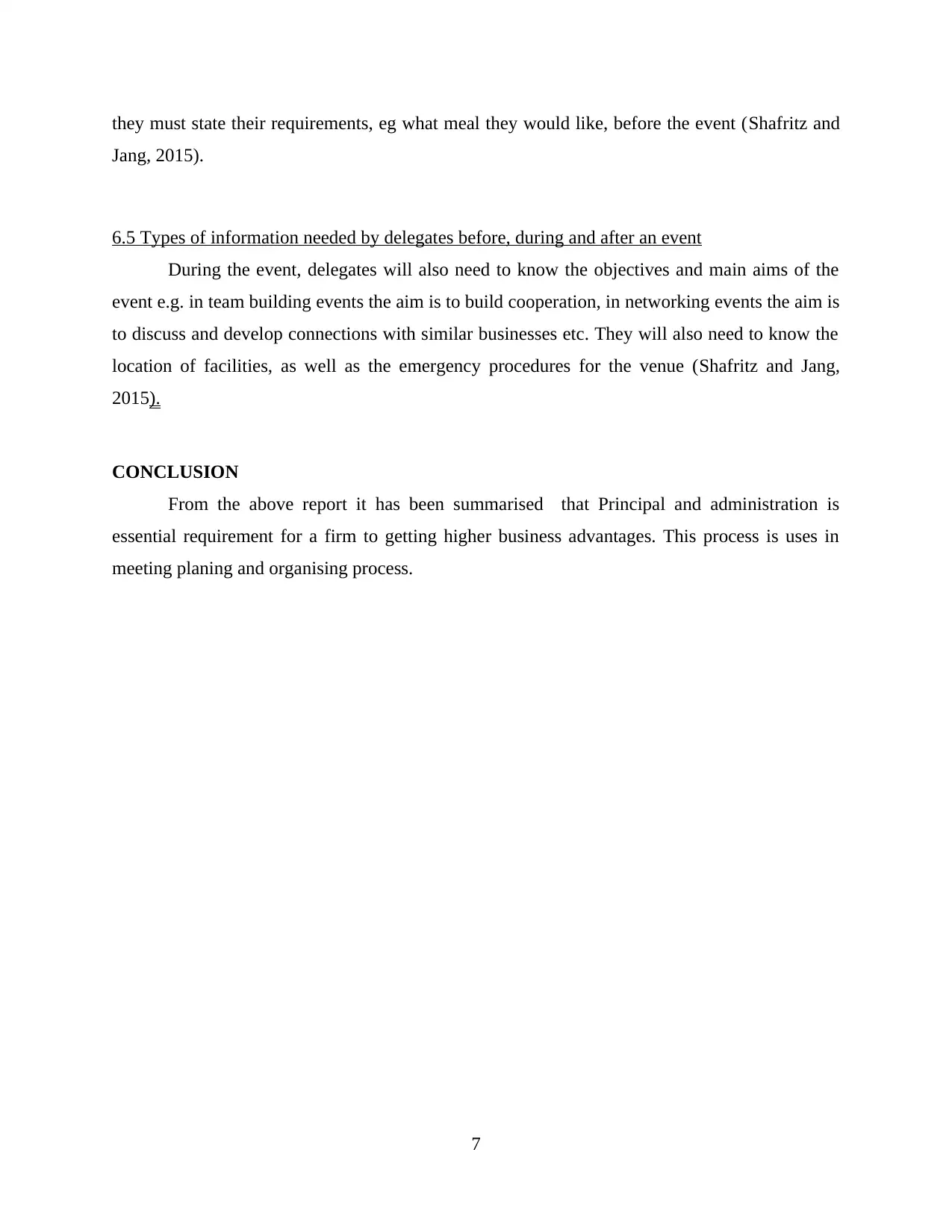
they must state their requirements, eg what meal they would like, before the event (Shafritz and
Jang, 2015).
6.5 Types of information needed by delegates before, during and after an event
During the event, delegates will also need to know the objectives and main aims of the
event e.g. in team building events the aim is to build cooperation, in networking events the aim is
to discuss and develop connections with similar businesses etc. They will also need to know the
location of facilities, as well as the emergency procedures for the venue (Shafritz and Jang,
2015).
CONCLUSION
From the above report it has been summarised that Principal and administration is
essential requirement for a firm to getting higher business advantages. This process is uses in
meeting planing and organising process.
7
Jang, 2015).
6.5 Types of information needed by delegates before, during and after an event
During the event, delegates will also need to know the objectives and main aims of the
event e.g. in team building events the aim is to build cooperation, in networking events the aim is
to discuss and develop connections with similar businesses etc. They will also need to know the
location of facilities, as well as the emergency procedures for the venue (Shafritz and Jang,
2015).
CONCLUSION
From the above report it has been summarised that Principal and administration is
essential requirement for a firm to getting higher business advantages. This process is uses in
meeting planing and organising process.
7
Paraphrase This Document
Need a fresh take? Get an instant paraphrase of this document with our AI Paraphraser
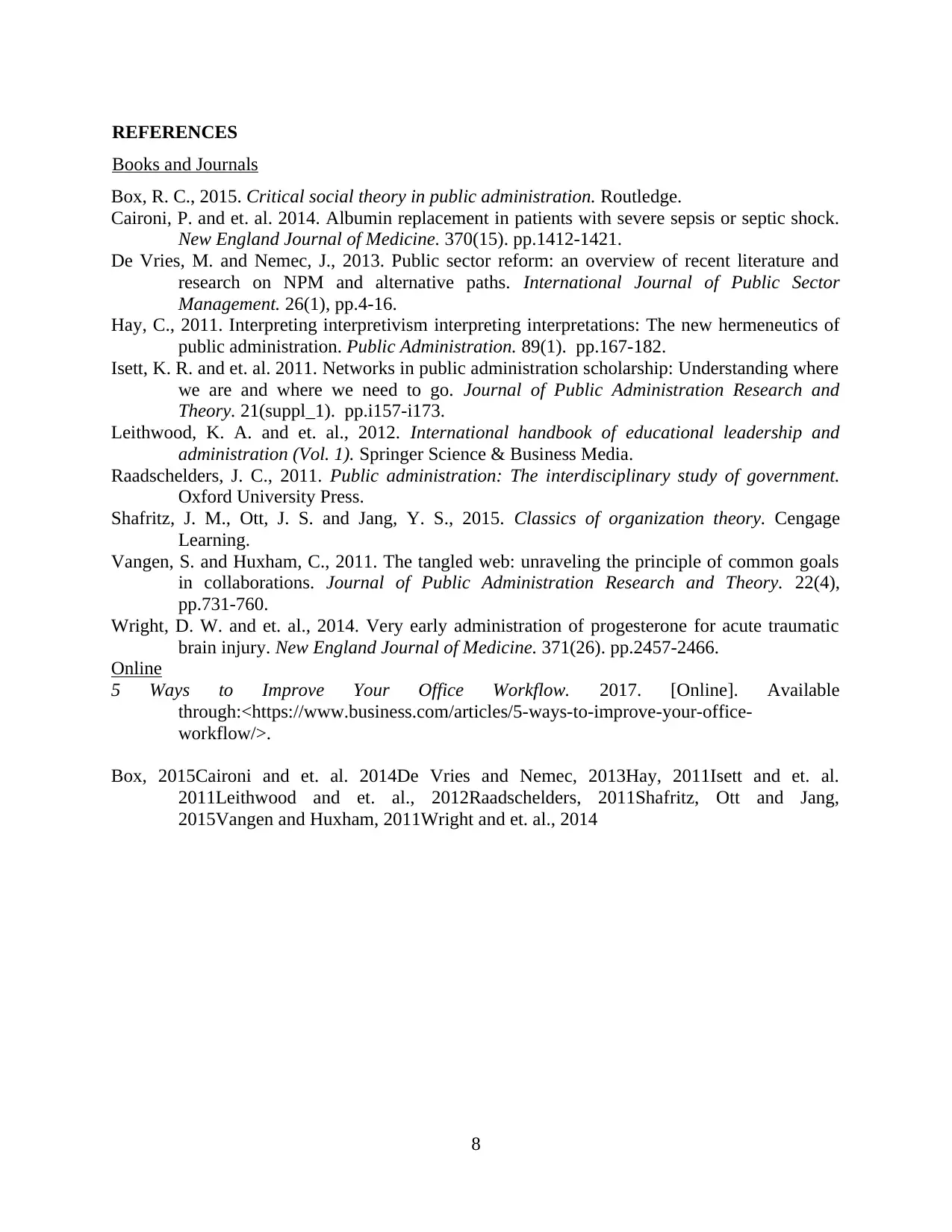
REFERENCES
Books and Journals
Box, R. C., 2015. Critical social theory in public administration. Routledge.
Caironi, P. and et. al. 2014. Albumin replacement in patients with severe sepsis or septic shock.
New England Journal of Medicine. 370(15). pp.1412-1421.
De Vries, M. and Nemec, J., 2013. Public sector reform: an overview of recent literature and
research on NPM and alternative paths. International Journal of Public Sector
Management. 26(1), pp.4-16.
Hay, C., 2011. Interpreting interpretivism interpreting interpretations: The new hermeneutics of
public administration. Public Administration. 89(1). pp.167-182.
Isett, K. R. and et. al. 2011. Networks in public administration scholarship: Understanding where
we are and where we need to go. Journal of Public Administration Research and
Theory. 21(suppl_1). pp.i157-i173.
Leithwood, K. A. and et. al., 2012. International handbook of educational leadership and
administration (Vol. 1). Springer Science & Business Media.
Raadschelders, J. C., 2011. Public administration: The interdisciplinary study of government.
Oxford University Press.
Shafritz, J. M., Ott, J. S. and Jang, Y. S., 2015. Classics of organization theory. Cengage
Learning.
Vangen, S. and Huxham, C., 2011. The tangled web: unraveling the principle of common goals
in collaborations. Journal of Public Administration Research and Theory. 22(4),
pp.731-760.
Wright, D. W. and et. al., 2014. Very early administration of progesterone for acute traumatic
brain injury. New England Journal of Medicine. 371(26). pp.2457-2466.
Online
5 Ways to Improve Your Office Workflow. 2017. [Online]. Available
through:<https://www.business.com/articles/5-ways-to-improve-your-office-
workflow/>.
Box, 2015Caironi and et. al. 2014De Vries and Nemec, 2013Hay, 2011Isett and et. al.
2011Leithwood and et. al., 2012Raadschelders, 2011Shafritz, Ott and Jang,
2015Vangen and Huxham, 2011Wright and et. al., 2014
8
Books and Journals
Box, R. C., 2015. Critical social theory in public administration. Routledge.
Caironi, P. and et. al. 2014. Albumin replacement in patients with severe sepsis or septic shock.
New England Journal of Medicine. 370(15). pp.1412-1421.
De Vries, M. and Nemec, J., 2013. Public sector reform: an overview of recent literature and
research on NPM and alternative paths. International Journal of Public Sector
Management. 26(1), pp.4-16.
Hay, C., 2011. Interpreting interpretivism interpreting interpretations: The new hermeneutics of
public administration. Public Administration. 89(1). pp.167-182.
Isett, K. R. and et. al. 2011. Networks in public administration scholarship: Understanding where
we are and where we need to go. Journal of Public Administration Research and
Theory. 21(suppl_1). pp.i157-i173.
Leithwood, K. A. and et. al., 2012. International handbook of educational leadership and
administration (Vol. 1). Springer Science & Business Media.
Raadschelders, J. C., 2011. Public administration: The interdisciplinary study of government.
Oxford University Press.
Shafritz, J. M., Ott, J. S. and Jang, Y. S., 2015. Classics of organization theory. Cengage
Learning.
Vangen, S. and Huxham, C., 2011. The tangled web: unraveling the principle of common goals
in collaborations. Journal of Public Administration Research and Theory. 22(4),
pp.731-760.
Wright, D. W. and et. al., 2014. Very early administration of progesterone for acute traumatic
brain injury. New England Journal of Medicine. 371(26). pp.2457-2466.
Online
5 Ways to Improve Your Office Workflow. 2017. [Online]. Available
through:<https://www.business.com/articles/5-ways-to-improve-your-office-
workflow/>.
Box, 2015Caironi and et. al. 2014De Vries and Nemec, 2013Hay, 2011Isett and et. al.
2011Leithwood and et. al., 2012Raadschelders, 2011Shafritz, Ott and Jang,
2015Vangen and Huxham, 2011Wright and et. al., 2014
8
1 out of 11
Related Documents
Your All-in-One AI-Powered Toolkit for Academic Success.
+13062052269
info@desklib.com
Available 24*7 on WhatsApp / Email
![[object Object]](/_next/static/media/star-bottom.7253800d.svg)
Unlock your academic potential
Copyright © 2020–2025 A2Z Services. All Rights Reserved. Developed and managed by ZUCOL.





